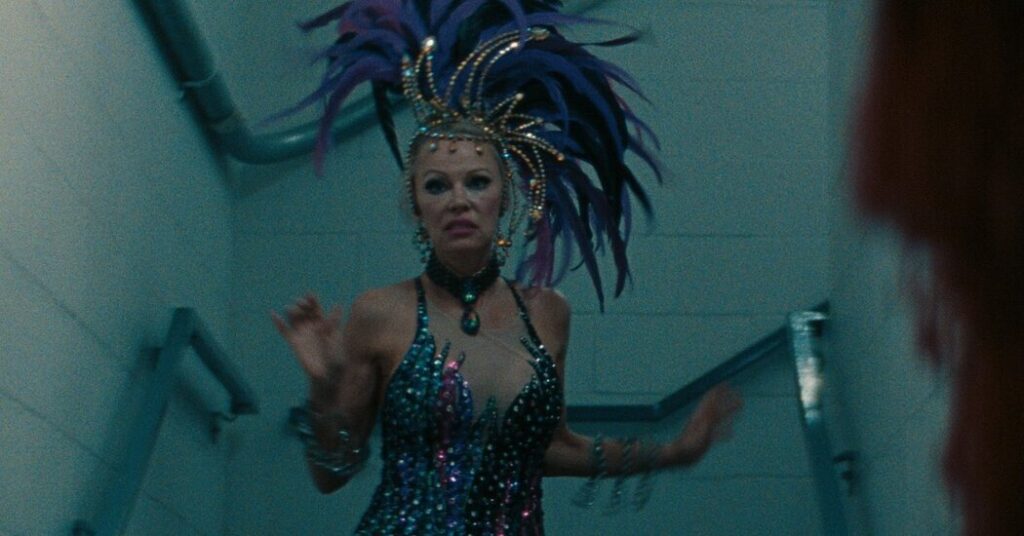“Diamonds are a girl’s best friend,” Marilyn Monroe cooed, but most of us have to settle for rhinestones. That’s long been true of Shelly, the title character played by Pamela Anderson in “The Last Showgirl,” a generous and sweetly elegiac ode to a fast-disappearing Las Vegas and to the women who helped build that gaudy oasis. Much like the Vegas statue known as the Blue Angel — a 15-foot-tall figure of a bodacious female seraph that was installed when the Rat Pack were in residence — Shelly has achieved monument status.
A veteran performer in a casino stage show called “Le Razzle Dazzle,” Shelly has for years — decades, if she’s being honest — floated onstage in a choreographed pageant, promenading amid a bevy of similarly bejeweled, semi-clothed dancers. Together, they made an old-fashioned revue spectacle a featured city attraction, and their talent and beauty has defined it as much as it has defined them. As one of the oldest dancers, Shelly also more or less grew up in “Le Razzle Dazzle,” and her image still adorns its souvenir brochure. After a long slide toward irrelevance, though, the show is on its last fishnet leg, leaving her at an impasse.
Directed by Gia Coppola (“Palo Alto”) from a script by Kate Gersten, “The Last Showgirl” tells a familiar story of bad luck and outwardly questionable choices with gentleness, a great deal of love for its characters and an obvious appreciation for the affirming highs and bitter lows that age and beauty afford. Modestly scaled and loosely plotted, it is an unusually tender movie and an ideal vehicle for Coppola’s gift for expressing the intangible and the ephemeral. Everyday life has its dramatic intensities, but she also understands the power of silence, the weight of an inchoate emotion, and how the warmth of the sun can feel like an embrace.
Shelly is already looking at her next chapter when the movie opens, and faces what look like some very bleak prospects. Over the course of the story, she labors to find a way forward while also trying to make peace with her adult daughter, Hannah (Billie Lourd), an aspiring photographer who nurses a grudge against her. This mother-daughter thread is one of several that the filmmakers pull and is, by far, the least engaging. Hannah is a drag, and so is her hectoring (the movie tries hard to pretend otherwise), but Shelly loves her and so you tolerate her. What’s most valuable about Hannah is the light that she sheds on Shelly.
Anderson has long been one of those celebrities who’s well known for her “well-knownness,” to borrow a formulation from the historian Daniel J. Boorstin. She received warm notices in a Broadway production of “Chicago” a few years back, but I doubt she’s often been asked to deliver a performance in which a character’s interior life matters as much as her appearance. That’s too bad, because she’s lovely in “The Last Showgirl.” Her range may be narrow, but her ability to be wholly vulnerable onscreen is rare and wonderful. She makes you see Shelly’s wounded sensitivities and feel them too, whether she’s just drifting through the city or sharing drinks and worries with her friend, Annette (a sensational Jamie Lee Curtis).
Coppola frames Anderson sympathetically throughout “The Last Showgirl,” visually as well as narratively; outside of Steven Soderbergh’s “Ocean’s Eleven,” Vegas has rarely looked more seductive. Working again with her regular director of photography, Autumn Durald Arkapaw — and shooting in 16-millimeter film — Coppola bathes the movie in a diffused light that softens every hard line in both the golden sunlight and electric night. She also makes eloquent use of custom camera lenses that markedly blur the edges of the image, a striking effect that, in certain close-ups, turns the characters’ surroundings into a luminous nimbus.
With Coppola, Anderson brings Shelly into focus one character-revealing detail at a time, including through her close relations with two younger dancers, Jodie (Kiernan Shipka) and Mary-Anne (Brenda Song), as well as with the show’s stage manager, the gruffly needy Eddie (Dave Bautista). When you first meet Shelly, she seems like another child-woman cliché, someone who, as Monroe’s Sugar Kane puts it in “Some Like It Hot,” always gets “the fuzzy end of the lollipop.” In time, you learn that there’s much more to Shelly than how others see her (and how you see her). Even when Shelly’s fluttery self-consciousness suggest that there’s a bit of Blanche DuBois in her Sugar Kane, the character transcends expectations.
So does “The Last Showgirl,” which centers the kind of woman who, once upon a Hollywood time, would have been relegated to the background, adding merely flash and flesh to sex up the scenery. Coppola clearly loves the flash and flesh of Vegas, its sparkle and its haze, but she loves her characters more, and she takes all of them on their own terms. By the time the film ends, you know a great deal more about Shelly and her world than you did at the beginning, but not because the character goes through some kind of hackneyed movieland journey of self-discovery and acceptance. You know her because Coppola makes you see the woman who’s been there from the start. All you have to do is open your eyes and heart to her dazzle.
The Last Showgirl
Rated R for Las Vegas life. Running time: 1 hour 29 minutes. In theaters.


